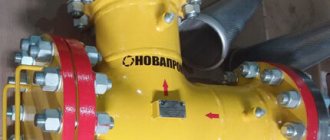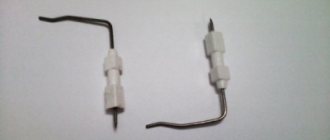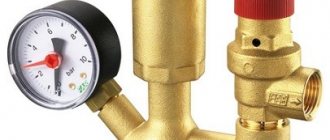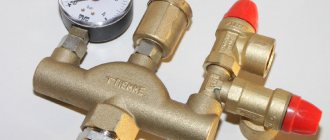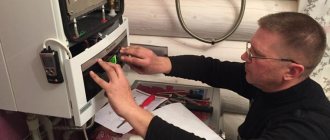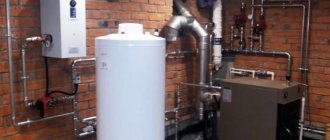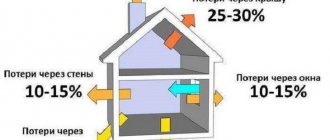Shut-off valves are designed to protect against accidents and tragedies. If there is any suspicion of a leak, the gas valve is first turned off, and then repair work is carried out. However, it is not always possible to sense the increased gas concentration in the room in a timely manner. Solenoid valves (or solenoid valves) were developed for such cases.
In this article we will analyze the design and operating principle of the solenoid valve, consider what types exist, and also study the requirements for installing these devices.
Purpose and device
A gas solenoid valve is designed to control gas flows in pipes.
A gas valve of this type can be regulating or shut-off, and is controlled manually or using an automatic system. In design and purpose, this element resembles its standard counterpart, with the difference that the locking part in it is driven by an electromagnet, supplemented by a movable core. When voltage is applied to the coil, it begins to push or pull in the core, which is connected to the rod. This part is intended for use in industrial installations, domestic heating systems and in the water supply sector. The valve device has a standard design:
- housing with two pipes;
- chamber with saddle;
- the locking part is of a disc, petal or spherical type;
- return spring;
- rod for connection with the locking part and the core;
- solenoid.
The housing for installation is made of non-magnetic metal alloys or durable plastic. Its optimal tightness allows the valve to be used in a variety of environments. The process of controlling the part is carried out via wires that are connected to the electrical contacts of the sensor located on the outside of the housing.
The valve must meet the required level of resistance to noise, vibration and electromagnetic fields.
Why do you need a solenoid valve: description and purpose
Unlike a thermal shut-off valve (which shuts off the gas supply at high temperatures, for example, in the event of a fire), the solenoid valve is designed primarily to prevent an accident. While a conventional faucet has to be turned manually, modern shut-off valves are actuated automatically when current is applied to the solenoid coil. In this way, you can not only shut off, but also regulate the fuel supply using automation.
Such valves can be used in water supply, heating or gas pipelines. They are used in households, industrial facilities and automotive systems.
Classification of gas valves
Design of a solenoid valve for gas
Solenoid valve for domestic gas is divided into categories depending on external features, operating environment, method of operation and installation, as well as a number of other nuances.
By type of execution
Taking into account the position of the main element and its diagram, the gas shut-off valve can be normally open or closed. In the first case, a passage for gas or liquid will be open in the element; when voltage is applied, it will automatically close; in the second case, this process occurs the other way around. In addition to such devices, there are their universal analogues, working in two directions at once.
By type of work environment
Taking this parameter into account, fittings of this type are produced specifically for operation in air, steam, water, fuel and lubricants or active media. Devices operating in radiation conditions are made of special resistant materials.
According to operating features
According to the characteristics of the external environment, the gas electrovalve is manufactured for operation under normal conditions, especially for rooms with high levels of humidity, operation at high and extremely low temperatures. The valves are also complemented with explosion protection provided by special parts and materials.
According to the operating principle
The operating principle of a magnetic valve depends on the voltage type of the coil, which can be AC or DC. Elements of the first type are used for high-pressure main pipelines, the second - for pipes with a small cross-section and low pressure.
From the number of saddle strokes
The functioning of the element is influenced by the number of strokes, depending on which it can be one-way, two-way or three-way, taking into account the number and type of valve nozzles. Depending on the design, they can be incoming or outgoing.
By type of control
The electric valve for domestic gas operates in two ways; according to the type of control, such fittings can be direct or indirect. Parts of the first type are designed for environments with a complete absence of pressure; their analogues of the second type are supplemented with a pilot element, which is activated automatically when there are differences in the medium at the inlet and outlet.
By type of functionality
The functionality of the valve depends on the material from which it is made. Most often, such elements are made from elastic polymers of various groups, which are made using special technology. Due to their high strength, they can withstand temperatures from -40 to +250 degrees.
Installation and operation
Before starting installation work, the pipeline must be empty and the electrical circuit de-energized. Masters also recommend adhering to the following rules:
- the solenoid valve is installed in a horizontal position, with the coil facing up;
- The installation location can be anywhere, the main thing is that there is organized free access to the valve for further maintenance and repair;
- It is recommended to install an additional filter to prevent contamination and damage to parts;
- the direction of movement of the medium must correspond to the direction indicated by the arrow on the device body;
- the solenoid valve should not be subject to load from pipelines (bending, compression, etc.);
- if the valve is installed outdoors, then it should be protected from various natural phenomena - usually a heated casing is enough to protect it from water and low temperatures;
- After installation, the valve must be checked for leaks.
Principle of operation
The operation of the device is based on the principle of electromagnetic instruction, when current flows through the coil, a magnetic field is formed inside it, affecting the core, depending on the position of which the gate element opens or closes. A valve for any gas pipe can have a different control voltage. Low level devices are low power, so they operate using low voltage semiconductor circuits. Such valves are used in systems with low pressure working media, on gas pipelines with a small diameter.
Drives operating on alternating current are considered more efficient, for this reason they can be installed on main pipelines with high pressure.
How does the autoblock work?
Manufacturers produce control units that include all of the above devices. Even if they look different, their operating principle still remains the same.
Automation from the Italian manufacturer EuroSIT is very popular. You can note the 630 brand, which has many functions, reliability and a long service life. Let's consider the design of an automatic block of this model.
The EuroSIT 630 automatic unit consists of the following elements:
- A casing, which consists of a pressure regulator module, a spring valve and a shut-off valve. Thanks to this, its design is simplified.
- Gas is supplied through a pipe connected to the housing.
- Cables from sensors and other elements are connected to the housing.
Scope of application
Household and industrial devices
The standard solenoid gas valve has a wide range of applications and can be used in all areas where there is a need to control remote flows of liquids and gases. This list includes heating systems, water treatment and water supply, irrigation and sewerage systems, household appliances, and pipeline transport. The device is rarely used for vehicles, but its relevance is increasing in other industries.
Adjusting the power of a gas boiler
In this case, the task is to reduce or increase the indicator. The indirect method of adjustment involves reducing the supply through the taps: the one located after the supply to the boiler and the one on the downstream side. The range of regulation will decrease, so it is better to prefer direct methods.
To increase power, select an option:
- Adjust the burner to the desired level - relevant for modulating units.
- Buy a more efficient burner.
- Replace the injectors with larger ones. Remember, with an increase in heat transfer from the boiler, gas consumption will increase, the risk of breakdown ahead of schedule, and the efficiency will decrease.
Ideally, it is better to entrust the adjustment to increase power to a boiler specialist. The increase in power for these options reaches 15%. If this is not enough, use additional devices to heat the rooms. Remember to clean the boiler to maintain power levels.
Tubes with micro-torches for an atmospheric burner - such a device operates almost silently, but is characterized by low power, dries out the air in the room and depends on a large number of external factors
Sometimes you have to reduce power. First, it is adjusted through the menu: by parameters of the heat exchanger temperature and anti-cycling time. Then set up the circulation pump. If necessary, change the burner to a modulating one.
Reasons for changing boiler power:
- Increase: it is necessary to re-equip the device at the same time as increasing the power, connect an indirect heating boiler, the heating area has increased.
- Reduction: refusal of one of the functions (heating or hot water supply), part of the functionality (heating of individual rooms, heated floors), reduction in boiler performance.
If there is excessive fuel consumption, it is worth inspecting the secondary heat exchanger and removing residual salts manually or with a chemical compound. Contamination will be indicated by a characteristic gurgling sound when the boiler is operating.
Consumption increases due to the low specific heat of combustion (calorific value) of the gas. The norm is no less than 7,600 kcal m³. Poorly dried fuel's calorific value drops by almost half.
Also adjust the gas valve. They are regulated depending on the structure:
- single-stage ones have only “on” and “off” positions;
- two-stage valves are equipped with 1 inlet and 2 outlets, and they open in an intermediate position;
- three-stage boilers have two power levels;
- With the help of modeling valves, power can be adjusted more smoothly; they have many flame modes, in addition to the “on” and “off” positions.
Look at the color of the flame. If there is a noticeable yellow part, tighten the lower valve to reduce the fuel supply.
845 SIGMA Multi-Function Gas Valve with Power Modulation, Outlet Pressure Regulator and Fuel Control Module - Accommodates a variety of threads and flanges
Set the heating operating temperature on the thermostat again. The principle of its operation is that the rod is turned on. As the temperature drops, the element shrinks and opens the fuel supply. An increase in temperature leads to an increase in the rod, causing gas to flow in a smaller volume.
If there is a lack of air, inspect the damper, boost and temperature regulator. A popping sound when igniting the main burner appears due to clogged air supply paths. Remove dust from them and inlet openings.
Valve selection criteria
To select a valve capable of regulating liquid and gas flows at full strength, you need to pay attention to the basic parameters. The main criterion is the working pressure of the part, which must correspond to the system in which it will be installed; the limit value can reach 200C. In addition, the connection diameter, measured in inches or millimeters, is taken into account. It is worth remembering that often the bore area of the device is smaller than the nominal bore. You will also need to consider the environment of use of the part, which must be compatible with the material from which it is made, and the voltage of the valve coil, which is 24 or 220 volts.
Device Maintenance
Self-service involves removing dust from the device. If a breakdown is detected, you need to call an employee of the gas company.
Maintenance includes annual metrological verification of the sensor. Outside this period, it is carried out when replacing sensors. Valve operation is checked by specialists every six months
It is prohibited to carry out maintenance of the devices yourself. Intentional supply of a non-special gas mixture can lead to damage to the sensitive elements of the device.
Installation of the device
Installation diagram in an apartment
The valve is connected by specialists or independently if you have the appropriate skills and qualifications. First, the principle of connecting the part is determined, which can be threaded or flanged.
In the first case, the outlet and inlet pipes will be supplemented with external or internal threads and fittings through which the fittings are built into the pipeline; this method is considered more convenient for DIY installation.
In the second case, the pipes and pipe ends are supplemented with flanges bolted together. This option is most often used for lines with medium or high pressure. Before installation, you will need to mark, cut and clean the pipes, and also select a suitable location for the device. The device is connected in accordance with the directions of the arrows marked on its body, which indicate the direction of flow.
The pipeline system must be supplemented with a filter to prevent contaminants from entering. When connecting the valve, it is necessary to follow safety rules and recommendations of professionals.
Setting, adjusting the bypass valve
In boilers, the forward and return heating pipelines are connected to each other through a bypass valve - bypass, pos. 1.
At a certain pressure difference in the forward and return pipelines, the valve opens and part of the water flows from the direct pipeline to the return pipeline. As a result, the difference in water pressure in the forward and return pipelines cannot exceed the value specified by the valve setting. The operation of the valve helps to avoid water hammer when the circulation pump is turned on. In addition, the valve setting limits the maximum speed of movement (flow) of water in the heating circuit.
The valve response pressure is determined by the position of the adjusting screw, item 1 in the figure. The screw can be rotated 10 turns from one extreme position to the other. Factory setting - the screw is set to the middle position, rotating 5 turns counterclockwise from the extreme right position. The valve opens at a pressure difference of 0.25 bar.
If the heating radiators are heated unevenly in height - the top is hot and the bottom is cold (the difference is more than 15-20 ° C), then it is necessary to increase the speed of water movement in the heating system. To do this, turn the bypass valve adjusting screw clockwise. The valve response pressure increases to 0.35 bar.
If noise is heard in the radiators or control valves during operation of the circulation pump, then the speed of water in the heating circuit should be reduced. To do this, rotate the screw counterclockwise. The valve response pressure is reduced to 0.17 bar.
The difference in pressure values that are displayed on the boiler display during operation of the circulation pump and immediately after it stops should not be more than 0.2-0.4 bar. If it is more, then you need to drain the water from the boiler, unscrew it and check the cleanliness of the bypass valve.
Three way valve for gas boiler
Three-way valve for a gas boiler in heating mode.
In DHW mode, the rod with the valve moves upward. To empty the boiler, the stem with the valve is set to the middle position through the service menu (menu line d.70).
Advantages and disadvantages
The solenoid gas valve has many advantages and virtually no disadvantages. Its main advantage is the ability to quickly and remotely regulate flows in the work environment. With its help, you can connect to an automated and centralized control system, which significantly increases the efficiency and accuracy of parameter control compared to manual operation.
The element helps to significantly reduce the costs of technological processes, increase production safety and reduce the impact of hazardous factors in the production environment, as well as increase the operating efficiency of various devices and installations. The solenoid valve drive is not equipped with a gear or worm gear, which significantly increases its reliability and ease of control.
The main disadvantage of the device is the inability to smoothly regulate the opening of the shutter, which can only be in the open or closed position.
Possible malfunctions and how to fix them
It is worth noting that high-quality installation and compliance with all operating rules specified by the manufacturer ensure reliable and long-term operation of the device.
But there are cases when the valve fails much earlier:
- Valve depressurization - most likely small mechanical particles have gotten inside the device. We recommend dismantling and disassembling the device, and then installing it together with an additional filter.
- The induction coil can fail if the voltage power is incorrectly supplied, or if the temperature or pressure inside the gas pipeline is exceeded. In addition, moisture may enter the coil, causing a short circuit. In all cases, it is recommended to dismantle the devices and replace the coil.
- Incomplete opening or closing of the valve may be due to contamination of the internal parts, a defective membrane, or voltage remaining on the solenoid.
In any case, repairs to the device can only be carried out by a qualified employee of a specialized organization with permission to work.
IMPORTANT!
The solenoid gas valve does not act as a gas tap, so a gas tap must be installed between the gas line and the valve. If you plan not to use gas for a long time, for example in winter, shut off the gas supply using the gas tap, not the valve.
Secondary heat exchanger
Responsible for heating water for household needs. Considering the design of a gas boiler, it is worth noting that this element is made of food-grade stainless steel plates. On one side, heated heating fluid moves through the heat exchanger, and on the other, cold water. When the heating fluid meets, it transfers its heat to cold water through a thin layer of metal. In this way, the water is heated and then flows into consumers’ taps. In this case, the heating fluid loses its temperature, entering the primary heat exchanger for subsequent heating. Such a heat exchanger has from 8 to 30 alternating layers and allows you to heat a fairly large amount of water.
Manufacturers
Let's look at the most common companies that produce gas valves.
A company from Germany, which is considered one of the most popular in the manufacture of gas control valves.
Dungs products began appearing on the Russian market in 1999 and were able to firmly secure their own position. Customers regularly purchase products from this manufacturer because they are distinguished by good quality, reliability and long service life.
Double gas valve device DUNGS view DMV
The only drawback that can be emphasized is the high price.
The most technologically advanced development of the Dungs company in the mass segment is considered to be the Dungs DMV-D valve - this is a two-way device, which is essentially considered to be a connection of two independent valves in one compact body. Thanks to its own technical properties, it can work in high pressure working environments (up to 500 mbar). The cost of devices starts at approximately 12,000 rubles.
The Italian manufacturer SIT GROUP began its operations in the first half of the 50s of the twentieth century. The company has been in existence for more than 60 years and after this time has managed to establish itself extremely favorably. The company's products have become widespread due to their good quality/cost ratio.
Gas valve SIT 845 SIGMA
The Sit 845 Sigma valve is the most common device that can be purchased in the inexpensive price category. The 845 Sigma gas valve has a two-way design that can be mounted on gas-consuming appliances from many popular manufacturers; it is also suitable for gas water heaters. This valve is equipped with an electric drive, due to which its operation requires a stable voltage of 220 Volts, in the absence of which the shut-off mechanism of the valve takes the closed position. The main positive qualities of the 845 Sigma are the shortest turn-on period of the valve and its small size.
The model makes it possible to adjust the limit level of gas pressure at the outlet. The process of installing the device on a pipe wire is carried out using a flange type connection. The valve for gas water heater Sit 845 Sigma can be purchased for approximately 6,000 rubles.
Similarly, the gas valve is responsible for the automatic supply of gas.
Conclusions and useful video on the topic
Adjusting the power of a gas boiler:
Setting up a room thermostat - lt08 models:
Detailed settings in the Bosch Gaz 6000 W boiler menu:
Now you know what kind of regulation boilers need. Do you understand how you can influence gas consumption? You can adjust the power of a gas boiler and its components without calling a technician. Take care of your device so that you can use what you learn only for adjustments and not for repairs. Do only what you can do. If necessary, contact a boiler specialist. Call emergency numbers if there is danger.
Write comments about setting up gas boilers. Write about the criteria by which you chose your device, about the quality of the device. Tell us how you tune your boiler and how often you do it. The feedback form is located below.
Types and differences
There is a main division of all models of electromagnetic valves into three groups:
- Normally open (NO). When the voltage is turned off, devices in this group remain in the open position and ensure free flow of gas.
- Normally closed (NC). Solenoid valves without electrical current are in a closed position and block the free flow of gas in the gas system.
- Universal. This type of gas valve can be in either a closed or open state when the voltage is turned off.
It is worth noting that electromagnetic gas valves can also be divided according to the principle of shutter movement:
- Direct action. This assumes that the shutter is only activated when the core moves.
- Indirect action. When the shutter moves not only under the influence of the core, but also under the influence of gas. It is beneficial to buy an electromagnetic valve for gas of this type if a large flow is expected, because it saves the effort of the system.
According to the number of moves there are:
Flanged Solenoid Valve
- Two-way solenoid valves. They have only two holes: inlet and outlet. This type of device is best used when you only need to supply or shut off gas to the system.
- Three way valves. They have three holes: one inlet and two outlets. Its advantage is that it is possible to redirect the gas flow through the system.
- Four-way solenoid valves. They have four holes: one inlet and three outlets. The advantage here is not only the ability to redistribute the gas flow, but also to connect to additional systems.
Tips for choosing
Before you buy a Lovato BH series magnetic gas valve, it is worth discussing where this device will be used and what characteristics it should have.
You should pay attention to the following conditions:
- Electrical maintenance. It is best to choose models with additional manual adjustment, or intrinsically safe ones with low power.
- Pipeline pressure. Do not select a valve with a pressure rating that exceeds the pipeline pressure. This may cause damage to the mechanism.
- Environment. You should check the valve specifications and make sure that the product can be operated under existing conditions. This is relevant when the room where the mechanism will be installed is expected to have high humidity, vibration, high (or vice versa, low) temperature, direct sunlight or any other parameters different from the norm.
- Required voltage. It is worth checking the power source for stable voltage. Uses a 220V gas solenoid valve, and if the voltage is lower, it will cause the mechanism to not be able to open and close normally. And with increased voltage, the device will overheat. This is also relevant on gas equipment of cars - then they install a 12 volt gas solenoid valve.
Gas solenoid valve
The price of a gas solenoid valve will vary depending on the type, size and application.
An electromagnetic valve for a gas water heater depends on the model of the water heater) will cost from $4 to $10. A Lovato magnetic gas valve for a car costs from $10 to $15.
Devices that are not used for household purposes are significantly more expensive. Let's also give a couple of examples.
A gas solenoid valve of the KGEZ type, depending on the configuration, will cost about $20-25.
A VN series solenoid valve for a gas gun will cost $43.
Installation nuances
The Lovato BH series solenoid valve is installed for rooms after the gas valve. It is recommended to install a filter in front of the valve.
To correctly install the mechanism, it is necessary to place the arrow on the body in the direction of the gas flow.
The column assembly must be positioned either horizontally or vertically.
The connection is made using threads (when small-diameter models are used) or using flanges for pipes with a large cross-section.
An electromagnetic gas valve is one of the pipeline fittings devices designed to distribute and regulate the working environment in gas supply systems, as well as on gas pipelines. The main distinguishing feature of the electromagnetic gas valve is remote control, which is carried out using electricity. An electrical impulse initiates the movement of an electromagnet in a given direction, which in turn sets the movement of the shutter.
Typical breakdowns and repair methods
The types of valves listed above perform ambiguous functions and differ in design. The reasons why they become unusable and the ways to fix the breakdown also differ.
Gas valve malfunctions
The main purpose of the gas valve is to regulate the gas pressure supplied through the nozzles to the burner. The flow can be adjusted so that from 25 to 100% of the flow enters the chamber. It all depends on what type of gas will be used in the operation of the equipment, how much air will be supplied for normal combustion.
In fact, it is an electromagnetic device, the main work of which is carried out only when connected to the power supply. However, when its solenoid coils are de-energized, the gas valve functions as a safety feature. In this case, it tightly blocks the channels through which gaseous fuel moves.
The charge generated by the thermocouple of the gas water heater or heating boiler hits the electromagnet (coil) of the gas valve, as a result of which the metal washer of the shut-off valve is magnetized to the coil. The washer opens the membrane so that gas can pass to the igniter and burner block nozzles.
When the flame fades or decreases below standard values, the thermocouple stops generating electricity. As a result, the coil holding the washer is demagnetized. The blue fuel supply channels are closed.
The need to take action will be indicated by a drop or increase in static pressure, i.e. inlet pressure when the boiler is not operating. For units processing main gas, it must be at least 17 mbar. For boilers powered by liquefied fuel - not lower than 35 mbar.
The list of typical gas valve failures includes:
- Disturbances in the electrical circuit supplying the electromagnetic device. In this case, all wiring and contacts in the connection areas should be checked with a multimeter. If a break is detected, it is eliminated in a trivial way: by replacing the damaged wire, stripping and tightening the contacts.
- Gas valve clogged. The channels of the device can periodically become clogged with mineral particles supplied along with low-quality gas, elemental carbon deposits and calcium salts formed when there is condensation in the supplied fuel. Simple mechanical cleaning helps.
- Thermocouple failure. Often requires complete replacement due to complete burnout of the working edge. In this case, no current is transmitted to the electromagnet at all, as a result the boiler does not ignite at all or is blocked after a couple of minutes of operation.
- Mechanical damage to the gas valve. For example, the washer above. It either stops pressing tightly and ensuring a tight seal, or does not respond to adjustment, which is why an uncontrolled volume of gas enters the chamber. To eliminate this, either the valve or the damaged part is replaced.
- Short circuit to the housing of the electromagnetic coil winding. Most often it occurs due to short-term overheating and subsequent melting of the plastic sleeve on which the turns of the electromagnet are wound.
It is clear that the list of all breakdowns can be divided into two groups: violations in the electrical part and mechanical damage to parts.
We immediately warn you that when carrying out any repairs for which it will be necessary to remove the unit body, the owner automatically deprives the owner of the right to take advantage of the manufacturer’s warranty. In addition, neither the company nor the organization with which the service contract is concluded will bear the slightest responsibility for a negative result.
It happens that instead of learning how to properly repair the solenoid valve of a gas boiler, the owner of the unit stubbornly tries to turn it on. At the same time, he continuously presses the button on the gas supply device, trying to start the burner. It is absolutely impossible to do this.
If you open the path to the gas flow yourself, the boiler burner will still not light. But the gas will flow uncontrollably into the room as long as the owner literally keeps his finger on the trigger. What is the threat? At best, mild poisoning, at worst, an explosion.
The following selection of photos will familiarize you with the steps to restore the electromagnetic coil of the gas valve:
What is automation for a gas boiler
After the gas boiler starts up, control over its operation is entrusted to a specialized device, which begins to operate within the framework of the program embedded in it. One of the main points of using automation for gas boilers is to ensure the safe operation of the device. And also all models automatically regulate the maintenance of the required and preset heat temperature in the rooms.
According to their functionality, automation for gas boilers is divided as follows:
- devices that are volatile;
- devices in which control devices are volatile.
The first type uses models that require electrical energy, they have a fairly simple design and operate on the principle of residual power. A pulse signal is received from a sensor that controls the temperature, also called a temperature sensor, and a valve operating on an electromagnetic principle, following the instructions of such a signal, closes and opens, thereby either interrupting the gas supply or, conversely, provoking it.
The second type includes energy-dependent devices that operate based on the properties of the physically used substance, the one that circulates inside the circuit of the device itself.
How and why to regulate the power of a gas boiler?
How to adjust the power of a gas boiler?
When setting up a single-circuit or double-circuit gas boiler, you can reduce or increase the power. By adjusting indirectly, you reduce it with taps.
You can increase power like this:
- Set the burner to the desired setting.
- Buy a new burner with higher performance.
- Change the injectors to those with a larger cross-section.
If you need to correctly reduce the power when setting up a gas boiler, then use the menu. Exchanger temperature and cycle time settings. And then they regulate the circulation pump.
Why you need to change the power of the equipment:
- Make it taller. The area of the room has become larger or there is a need to re-equip the device or connect a boiler.
- Do below. One heating, hot water or heated floor was turned off. There are fewer rooms. Boiler performance has dropped.
How to set the gas valve on the boiler?
How to set the gas valve on a boiler depends on the device:
- If the valve is from one stage, then it has an on and off switch.
- And when the valve is more complex in its design - 2 stages, then there will be an inlet and 2 outlets that open in between.
- With three stages there are 2 levels.
- When the valve is modeling, the power can be adjusted softly, adjusting the flame more accurately.
Set the degrees on the regulator. When the temperature drops, the element becomes small and gas flows well. And when the temperature rises, the rod is also larger and the gas flows less intensely.
If you see that there is not enough air, check the damper, regulator, boost. Popping noises during ignition may indicate that the air passages are clogged. It is worth removing dust from them and cleaning water holes.
Functions of HBO valves
Electromagnetic valves installed on gas equipment are called “multi-valves” because they perform several functions at once. To be more precise, the functional set of most nodes of this type includes:
- Possibility of refilling through a special fitting. Thus, the filling function of the valve allows you to fill the cylinder with fuel through it, if other methods for achieving this goal are not applicable for some reason;
- On the contrary, the possibility of emptying the cylinder through a special fitting;
- Blocking of filling and supply channels by using a valve mechanism;
- Blocking overfilling of the cylinder through the use of a special cut-off with a float;
- Blocking the gas supply through the line to the engine when its operation is stopped, which organizes the “anti-pop” function of the valve. This was especially true for equipment of the first generations, because the slightest problems with the gas supply to the internal combustion engine were accompanied by the sounds of pops and explosions. It was the multivalve - anti-clap that was the first to solve this problem;
- Determination of the gas level in the tank, thanks to a unique magnetic system for indicating its quantity;
- Filtration of gas in its liquefied state, which occurs due to the presence of a filter element in the structure of the unit;
- Organization of additional fuel replenishment of the engine.
Today, multivalves in their standard form with the set of functions noted above are practically not used, because such an LPG system is not absolutely safe. Despite this, such a giant in the field of universal gas valves as Lovato still produces a little of them for sale.
Solenoid multivalve
In all these HBO systems, regardless of the class and principle of operation, a device such as a multivalve plays a key role. It is he who allows and blocks gas, filters the composition of the mixture, selecting harmful substances and impurities (which is why the built-in filter needs to be replaced regularly).
Removing scratches on a car body without painting.
DON'T SPEND MONEY ON REPAINTING! Now you can remove any scratch from the body of your car in just 5 seconds.
Read more >>
Initially, a conventional mechanical valve had only a shut-off function and was tightly welded directly to the cylinder. The first generation of vacuum-type equipment begins to use a valve with an additional vacuum membrane, which plays the role of a vacuum level sensor in the manifold. Further complexity of the design and general unification of cylinder necks from various manufacturers led to an increase in the number of simultaneously performed work operations. A modern electromagnetic multivalve for a car consists of a whole set of built-in valves connected by sensor feedback to an electronic control unit.
